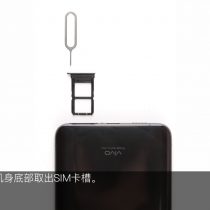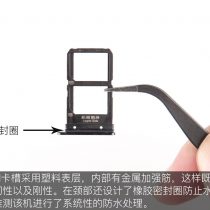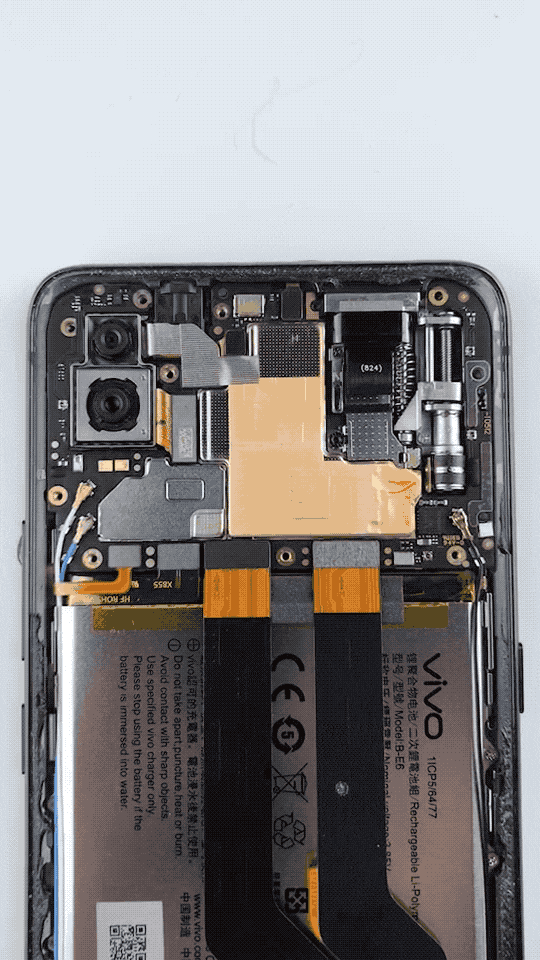On June 12, 2018, vivo held a new product launch event to introduce the vivo NEX. This phone features a 6.59-inch OLED screen with a resolution of 2316 x 1080 pixels and supports the third-generation under-screen fingerprint recognition technology. We have now obtained a Vivo NEX. Let’s start disassembling this phone to take a look at its craftsmanship and internal design.
First, remove the SIM card tray from the phone. The SIM card tray is made of plastic, while the interior is metal; such a design provides both flexibility and durability. In addition, the tray features a rubber ring to prevent water from entering.
There are no screws at the bottom of the phone body. Therefore, we first heat the back cover to reduce its adhesive strength, then use a suction cup to remove it. Unexpectedly, the screen came off instead of the back cover, which surprised me a lot. After removing the screen, we found that there were no screws inside.
We found new technology under the screen. The first technology is the third-generation under-screen fingerprint reader. Only a hole was found on the back of the screen. From this, we realized that the under-screen fingerprint reader in the vivo NEX is different from the technology used in the vivo X21.
A camera module with a special design is right below the fingerprint reader. This phone uses a short-focus lens to capture the user’s fingerprint information through the screen. Except for the under-screen fingerprint scanner, the hole at the top of the screen is also intriguing. It houses the under-screen light sensor. As is well known, OLED screens are transparent to light, and the larger the size of the light sensor, the more sensitive it is to light.
Since I couldn’t remove the back cover using a suction cup, I had to use a more violent method. I heated the back cover, inserted a blade between it and the phone body, and removed it without damaging the phone.
After removing the back cover, we found that the phone uses a three-segment structural design. Since the SIM card tray is at the bottom of the phone, the bottom of the phone occupies more space. The mainboard at the top is covered by a large metal shield. Although the camera is very prominent, I decided to remove the mainboard first to explore its structure. Therefore, I first disconnected the battery connector, then disconnected the cable connecting the bottom buttons to the sub-board.
The metal shield on the front of the motherboard is covered with a layer of copper foil, which helps dissipate heat. After removing the copper foil, several small components are visible, but the large metal shield cannot be removed. After removing the thermal grease on the surface, a Samsung K3UH7H7 8GB LPDDR4 memory chip is visible in the center. Below the memory chip is the Qualcomm Snapdragon 845 SoC. The flash memory is hidden under a baffle near the memory chip, making it impossible to observe directly. The secondary camera supports four-axis optical image stabilization.
This is a GIF showing the working principle of a spring mechanism. The spring is designed to absorb external forces applied to the camera, but in fact, the helical stepper motor on the right drives the entire feeding mechanism. We can see the structures on both sides of the stepper motor. This module is relatively expensive. Although the front camera is not motor-driven, it can still slide freely up and down. These are all the components obtained from disassembling the front camera.
The component that looks like a linear vibrator is an earphone. Vivo claims that this component is key to achieving screen sound. Therefore, its principle is entirely different from the piezoelectric ceramic speaker used in the Xiaomi MIX, but its acoustic principle is essentially the same.
Judging from the sealed cover design, we can infer that this vibrator unit is expensive. The vibrator lets the user hear a clear sound when close to the screen, even if the earphone end has no openings. Furthermore, compared to piezoelectric ceramic speakers, this design can deliver better sound quality.
The battery is secured onto a metal base, which is in turn secured by six screws. Therefore, before removing the battery, I need first to unscrew the six screws. When I first saw the battery packaging, I thought the supplier was Sony. I had seen similar packaging when disassembling the Sony XZ2 before. The Vivo NEX features a 4000mAh battery (15.4Wh) that supports 22.5W fast charging. The back of the battery shows that its supplier is ALT.
I have already removed the loudspeaker. The supplier of this loudspeaker is unknown. Besides, we can see that the cover protects a chip area on the front of the sub-board. The microphone and USB port have also been integrated there.
After disassembly, we found that vivo applied multiple new technologies in the vivo NEX smartphone. More importantly, despite the complex internal structure and the increased number of openings in the body, its waterproof and shatter resistance remain excellent. The craftsmanship of the vivo NEX is exquisite, and it uses high-quality materials with outstanding heat dissipation performance.



